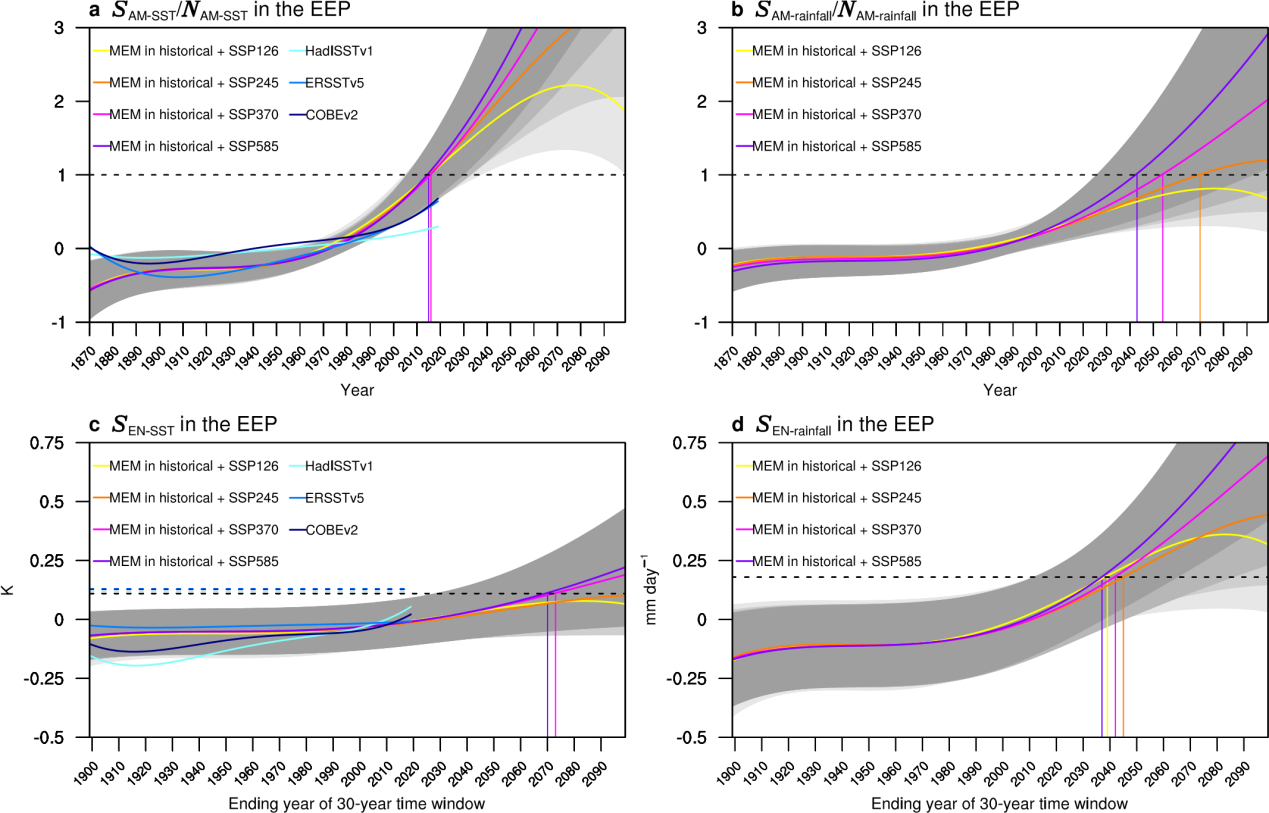News
On March 7, the international climate change journal-Nature Climate Change published an important research achievement of SIO entitled “Emergence of Climate Change in the Tropical Pacific”. Regarding this paper, the first corresponding author is Associate Researcher Ying Jun of State Key Laboratory of Satellite Ocean Environment Dynamica of SIO, and his collaborators include: Academician Chen Dake of SIO, Professor Mat Collins of University of Exeter, Academician Cai Wenju of Commonwealth Scientific and Industrial Research Organization, Professor Axel Timmermann and Professor Karl Stein of Korea IBS Climate Physics Research Center as well as Researcher Huang Ping of Institute of Atmospheric Physics, Chinese Academy of Sciences.
The tropical Pacific is the birthplace of El Niño-Southern Oscillation (ENSO), the strongest signal of short-term climate oscillations on earth. Its climate change in the context of global warming has always been the focus of research in the atmosphere and ocean science community. Previous studies have mainly focused on mean-state sea surface temperature (SST) and precipitation in the tropical Pacific as well as ENSO related sea surface temperature and precipitation’ response towards global warming. But whether these signals of global warming responses have exceeded signals of internal variability of upper climate system in the tropical Pacific is still unknown. This issue is not only the core content of climate change research, but also the focus of relevant countries when formulating polices to deal with climate change.
Regarding the above issue, the authors employed the newly released CMIP6 multi-model data to estimate the climate change signal appearance time of annual mean SST and precipitation in the tropical Pacific and for the ENSO respectively. According to the results of the multi-model ensemble average, the signal of annual mean SST change has already appeared in most regions of the tropical Pacific (Figure 1a) and the latest ones appeared in the eastern Pacific where ENSO anomalous signals occurred. The annual mean precipitation change signal appeared in the middle of this century, which has certain sensitivity to future greenhouse gas emission scenarios (Figure 1b). However, the ENSO SST and precipitation change signals have not appeared until now. It is estimated that ENSO precipitation change signal appears around year of 2040, which is about 30 years earlier than ENSO SST change signal (appears about year of 2070) (Figure 1c, d). In addition, the ENSO SST change signal is sensitive to future greenhouse gas emission scenarios (that is, the stronger (weaker) the emission scenario is, the earlier (later) the ENSO SST change signal appears), while the ENSO precipitation change signal is not sensitive to the emission scenarios.

Figure 1
Theoretical studies further show that annual mean SST change signal mainly reflects the signal of tropical mean SST change, while the annual mean precipitation change is mainly regulated by relative change of local tropical mean SST (that is, minus the change of tropical mean SST) (“warmer/wetter” mechanism). Since the tropical mean SST change signal appears earlier than relative SST change signal, the annual mean precipitation change signal appears earlier than annual mean SST change signal. Moreover, since the ENSO precipitation change is also regulated by the change of mean state vapor (the thermal part) and the atmospheric circulation driven by ENSO (the dynamic part, which is related to the ENSO SST change) and the signal of thermal part appears earlier than that of the dynamic part, ENSO precipitation change signal appears earlier than the ENSO SST change signal. The above conclusions are significantly reflected in most of the models and multi-model ensemble average.
Associate Researcher Ying Jun said: “previous studies have shown that ENSO-driven precipitation change will shift eastward under global warming, and our research suggests that this phenomenon may occur in next two decades. Moreover, one of the surprising conclusions is that the appearance time of ENSO-driven precipitation change signal does not change with different future greenhouse gas emission scenarios, which means that the ENSO-induced precipitation enhancement will be inevitable under global warming.” Considering the increasing global warming, this research result deserves our vigilance.
The research of climate change in the tropical Pacific is one of the research directions of the “Ocean Circulation and Climate Change” research team led by Academician Chen Dake of SIO in recent years. Since 2015, the team led by Academician Chen Dake has published papers in many top international journals such as Nature Geosciences, National Science Review, Journal of Climate, Geophysical Research Letters, etc. regarding the formation mechanism of El Niño diversity as well as the formation mechanism and uncertainty of zonal gradient of tropical Pacific SST under global warming.



